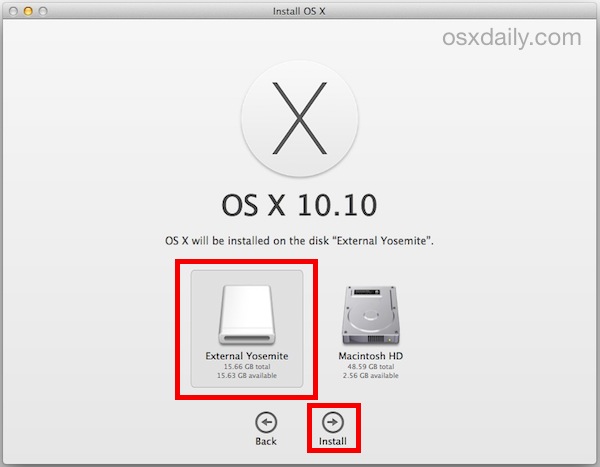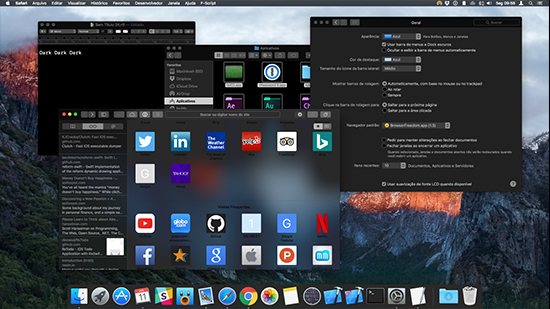- Download Os X Yosemite Dmg
- Mac Os Yosemite Download
- Mac Os X Yosemite Installer
- Install Macos Yosemite From Usb Windows 10
- Mac Os Yosemite System Requirements
- Mac Os Yosemite Iso Create Usb Installer Mac Os X Yosemite Sep 23, 2019 Once your bootable USB installation media is ready, remove it and insert it into your Mac, power it on, holding down the Option key, and select the USB you just created to reinstall Mac OS X.
- Install Yosemite Dmg From Usb Adapter Use the 'createinstallmedia' command in Terminal. Sep 03, 2015 Download Mac OS X 10.10 Yosemite.DMG – Download Yosemite.ISO – Yosemite Torrent download – VMWare image – Hackintosh Without Apple Store ID! Very shortly, in this article, we show 3 possible ways to download Yosemite 10.10.DMG, then.
For more info see my video helps you please like it.This video will show you how to do a clean install of OS X Yosemite from USB.For. Jun 05, 2014 Apple released the new Mac OS X 10.10 Yosemite in the Mac App Store for everyone to download and install for free on October 16th, 2014, but downloading a 5+ GB file for each of your computers will take some serious time. The best thing to do is download it once and create a bootable install USB drive from the file for all of your Macs.
One of the most awaited Operating System of 2014 i.e. Mac Yosemite is now available for use. Apple has recently released the beta version of the latest Yosemite OS with new and advanced features. Who wouldn’t like to try this latest version? Every Mac user would love it! You can easily work with and get familiar with all features of this new Yosemite that too without disturbing the already running Mac installation in simple steps. Yes! you can achieve this by just creating a bootable USB flash drive with Yosemite and then connecting it to the Mac desktop or laptop to install Yosemite from USB securely.
It’s just a few simple step procedure and within minutes you can create Yosemite bootable USB. The process involves two stages – creation of bootable USB flash drive and then installation procedure. Below is the complete step-by-step procedure to achieve this, just read on…
Stage 1: Create Bootable USB Flash Drive
- First connect your USB drive to the Mac computer and launch Disk Utility tool. Now select drive indicating USB flash drive (select the USB drive you want to make the bootable installer) from the available drives list
- Then just click on the “Erase” tab and format the drive as “Mac OS Extended (Journaled)”
- Then just click on “Erase” and confirm the selection
- Go to “Partition” tab and under ‘Partition Layout’ section click on the pull-down menu and change the layout to “1 Partition” from “Current”
- Change the partition name from “Untitled 1” to “Untitled” and then click on “Options” button
- Choose the partition scheme as “GUID Partition Table” and select “OK”
- Once done click on “Apply” to confirm the creation of the partition
- After the partition is successfully created download the Macintosh OS X 10.10 Yosemite installer from Mac App Store, once done quit the installer and set the downloaded file's name to Install OS X Yosemite app.
After completion, launch the Terminal app (located in Applications/Utilities) and type or copy - paste the following command, and then hit Enter:
sudo /Applications/Install OS X Yosemite.app/Contents/Resources/createinstallmedia --volume /Volumes/Untitled --applicationpath /Applications/Install OS X Yosemite.app –nointeraction
Once done Quit the Disk Utility; With this your OS X Yosemite bootable USB flash drive will be ready for use and you can start the clean installation process.
Stage 2: Clean Install OS X Yosemite on Your Mac
- Now, connect the bootable USB flash drive into your Mac and restart the computer, once the start-up chime plays, just press the Option key (Alt).
- On the start-up drive selection screen choose the USB drive and hit Enter / Return on the keyboard.
- The process might take few minutes, just wait until the Yosemite installer appears on screen
- Once it appears, click on Disk Utility and then hit Continue.
- From the left hand-side pane of the Mac, find and click on Macintosh HD and then on the top-right portion hit Erase tab. Select default values for all options and then hit Erase button at the bottom right; by doing this all files stored on the startup hard drive will be wiped off.
- After completion of the erasing process just return to the first screen and click on Install OS X and then hit Continue.
- Now, select the Macintosh HD partition that was erased in step 5 and then click Install
Download Os X Yosemite Dmg
By following all the above steps correctly, your computer will now boot into the newly installed OS X Yosemite, and you could just enjoy all its stunning new UI and advanced features. However, before performing the process make sure you have proper data backup, as there are chances of losing your data due to interruption or by selecting improper option. In such cases Remo Recover software could help you to perform Mac lost data recovery in just few minutes.
These advanced steps are primarily for system administrators and others who are familiar with the command line. You don't need a bootable installer to upgrade macOS or reinstall macOS, but it can be useful when you want to install on multiple computers without downloading the installer each time.
What you need to create a bootable installer
- A USB flash drive or other secondary volume formatted as Mac OS Extended, with at least 14GB of available storage
- A downloaded installer for macOS Big Sur, Catalina, Mojave, High Sierra, or El Capitan
Download macOS
- Download: macOS Big Sur, macOS Catalina, macOS Mojave, or macOS High Sierra
These download to your Applications folder as an app named Install macOS [version name]. If the installer opens after downloading, quit it without continuing installation. To get the correct installer, download from a Mac that is using macOS Sierra 10.12.5 or later, or El Capitan 10.11.6. Enterprise administrators, please download from Apple, not a locally hosted software-update server. - Download: OS X El Capitan
This downloads as a disk image named InstallMacOSX.dmg. On a Mac that is compatible with El Capitan, open the disk image and run the installer within, named InstallMacOSX.pkg. It installs an app named Install OS X El Capitan into your Applications folder. You will create the bootable installer from this app, not from the disk image or .pkg installer.
Use the 'createinstallmedia' command in Terminal
- Connect the USB flash drive or other volume that you're using for the bootable installer.
- Open Terminal, which is in the Utilities folder of your Applications folder.
- Type or paste one of the following commands in Terminal. These assume that the installer is in your Applications folder, and MyVolume is the name of the USB flash drive or other volume you're using. If it has a different name, replace
MyVolumein these commands with the name of your volume.
Mac Os Yosemite Download

Big Sur:*
Catalina:*
Mojave:*
High Sierra:*
El Capitan:
* If your Mac is using macOS Sierra or earlier, include the --applicationpath argument and installer path, similar to the way this is done in the command for El Capitan.
After typing the command:
- Press Return to enter the command.
- When prompted, type your administrator password and press Return again. Terminal doesn't show any characters as you type your password.
- When prompted, type
Yto confirm that you want to erase the volume, then press Return. Terminal shows the progress as the volume is erased. - After the volume is erased, you may see an alert that Terminal would like to access files on a removable volume. Click OK to allow the copy to proceed.
- When Terminal says that it's done, the volume will have the same name as the installer you downloaded, such as Install macOS Big Sur. You can now quit Terminal and eject the volume.
Use the bootable installer
Determine whether you're using a Mac with Apple silicon, then follow the appropriate steps:
Mac Os X Yosemite Installer
Apple silicon
- Plug the bootable installer into a Mac that is connected to the internet and compatible with the version of macOS you're installing.
- Turn on your Mac and continue to hold the power button until you see the startup options window, which shows your bootable volumes.
- Select the volume containing the bootable installer, then click Continue.
- When the macOS installer opens, follow the onscreen instructions.
Install Macos Yosemite From Usb Windows 10
Intel processor
Mac Os Yosemite System Requirements
- Plug the bootable installer into a Mac that is connected to the internet and compatible with the version of macOS you're installing.
- Press and hold the Option (Alt) ⌥ key immediately after turning on or restarting your Mac.
- Release the Option key when you see a dark screen showing your bootable volumes.
- Select the volume containing the bootable installer. Then click the up arrow or press Return.
If you can't start up from the bootable installer, make sure that the External Boot setting in Startup Security Utility is set to allow booting from external media. - Choose your language, if prompted.
- Select Install macOS (or Install OS X) from the Utilities window, then click Continue and follow the onscreen instructions.
Learn more
A bootable installer doesn't download macOS from the internet, but it does require an internet connection to get firmware and other information specific to the Mac model.

For information about the createinstallmedia command and the arguments you can use with it, make sure that the macOS installer is in your Applications folder, then enter the appropriate path in Terminal: